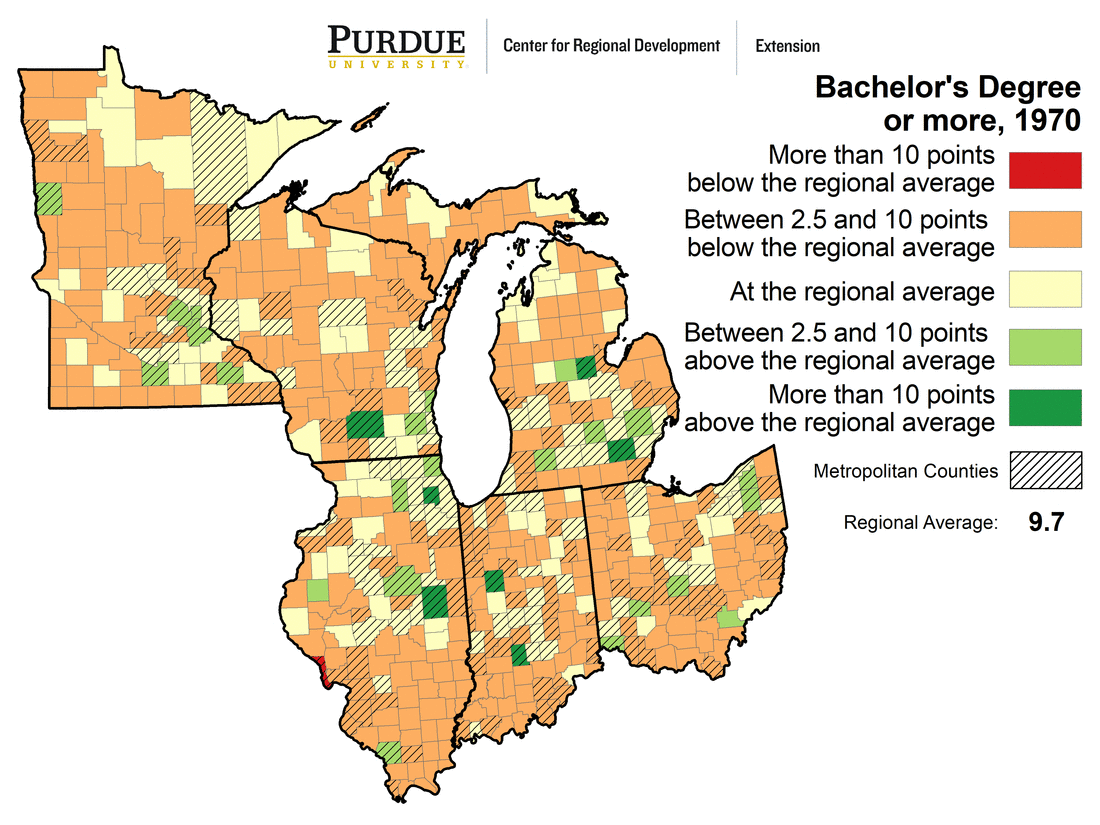Distribution of Talent in the Upper Midwest

Written by Roberto Gallardo and Bo Beaulieu.
In a previous post, we discussed how the increase in the share of adults (25 years of age and above) with a bachelor’s degree or more over the past 48 years was not geographically distributed equally. In the U.S., this share went from 10.6 percent in 1970 to 31.5 percent in 2018. Similarly, metropolitan, small city, and rural counties in the nation also saw their shares increase during this period.
The focus now shifts to the upper Midwest region that includes the states of Illinois, Indiana, Michigan, Minnesota, Ohio, and Wisconsin. As shown in the interactive table below (click on the years at the top to see the share over time), the region’s share of those with a bachelor’s or higher increased from 9.7 percent in 1970 to 30.2 percent in 2018. Minnesota had the highest percentage among the upper Midwest states analyzed in 1970 and 2018. On the other hand, Ohio had the lowest share in 1970 in the region while Indiana took this spot in 2018, the latest year available from publicly available datasets.
How did the geographic distribution play out during this time? The animated GIF below shows counties in the region exceeding (dark green) or lagging (dark red) the regional average by more than ten percentage points. Again, this does not mean counties in red lack workers with a bachelor’s degree or more. It only means its share is lagging compared to the regional average.
Counties were grouped into metropolitan, small city or micropolitan, and rural or noncore. These categories were obtained from the United States Department of Agriculture Economic Research Service Urban Influence Codes.
Results are similar to those seen in the nation. Metropolitan counties have outpaced the region’s average compared to rural or noncore counties. In other words, they have captured a higher share of those with a bachelor’s degree or higher between 1970 and 2018.
However, as discussed in the previous post, metropolitan counties are keeping a higher share of those with a bachelor’s compared to rural counties. So, how are rural counties in the region faring in this respect? The chart below shows the share with bachelor’s or more of rural counties in the area over time.
Rural counties in all states of the region increased their share of those with a bachelor’s or higher, experiencing an increase from 5.3 percent in 1970 to 17.4 percent in 2018. In 1970, Ohio had the lowest rural share, while Minnesota had the highest. By 2018, the situation had flipped with Ohio, now having the lowest rural share and Minnesota the highest. Wisconsin had the second-highest level of adults with baccalaureate degrees or higher by 2018.
Certainly, talent is not solely defined by those with a bachelor’s or higher. Several adults in the workforce have many skills that they have developed through on the job training or through specialized technical courses. This is evidenced by the share of workers with some college in the region (including an associate’s degree). The number of adults with some college grew from 9.7 percent in 1970 to 30.3 percent in 2018 (not shown).
When all is said and done, just over 60 percent of those ages 25 and over in the region had at least some college education by 2018. With the expanded demand in the workforce for higher-skilled workers, efforts to continue to build the human capital credentials of the adult workforce will be critical to the Midwest region’s capacity to compete in a global economy. This includes efforts to meet the growing need for middle-skilled workers who have the technical training and skills needed to succeed in an environment where automation is becoming commonplace in vital economic sectors of the region (such as manufacturing).
Where a concerted effort must be made is addressing the education and training needs of the rural workforce, and aligning these skills with the requirements of area industries and businesses. The number of rural adults with a high school education or some college is sizable. Seeking ways to help these individuals complete a technical degree or associate degree could be a worthwhile investment. At the same time, attracting and retaining firms that seek workers with these types of educational credentials will be essential as well.
One innovative strategy that holds promise in rural areas is to train the growing cadre of adults who are working, or wish to work, remotely. This would allow individuals wanting to reside in rural areas of the region to be employed by companies located in the region’s metropolitan areas. Improving broadband connectivity will be essential if the growth of a remote work residing in rural areas of the six-state region is to be fully realized.

Roberto Gallardo is the Vice President for Engagement, Director of the Purdue Center for Regional Development and an Associate Professor in the Agricultural Economics Department.... read more





